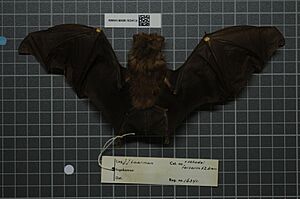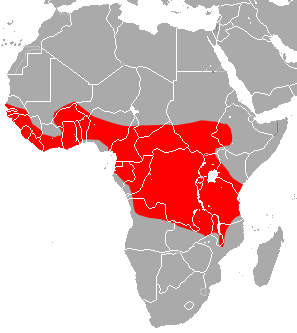Noack's roundleaf bat facts for kids
Quick facts for kids Noack's roundleaf bat |
|
|---|---|
 |
|
| Conservation status | |
| Scientific classification | |
| Genus: |
Hipposideros
|
| Species: |
ruber
|
 |
|
| Noack's roundleaf bat range | |
The Noack's roundleaf bat (Hipposideros ruber) is a type of bat found in Africa. It belongs to the family Hipposideridae. These bats live in warm, wet places like tropical forests, savanna grasslands, and even caves.
Contents
About Noack's Roundleaf Bat
This bat is also known by other scientific names, like H. centralis and H. niapu. When these bats are young or have just shed their old fur, they are gray. But as they get older, their fur often turns orange. Scientists think this color change might happen because of chemicals like ammonia found in the places where they sleep, called roosts.
Bat Behavior and Diet
Some groups of Noack's roundleaf bats are active during the day, which is unusual for bats! They have been seen flying, chasing, and doing other activities in daylight, especially on an island called São Tomé.
How Noack's Bat Hunts
Noack's roundleaf bats are clever hunters. They seem to find their prey, mostly moths, by feeling the tiny movements of the moths' wings. If a moth stops fluttering its wings, or if it wasn't fluttering them to begin with, the bat will stop its attack. This special hunting method helps the bat avoid confusion when there are many things around. It means they don't need to use their eyes or ears to detect the wing movements.
Echolocation: Bat's Superpower
Like many bats, Noack's roundleaf bats use echolocation to find their way around and hunt. This means they send out high-pitched sounds and listen for the echoes that bounce back. By listening to these echoes, they can create a picture of their surroundings. Noack's roundleaf bats make sounds at a frequency of 132-138 kilohertz (kHz).
Where Noack's Bats Live
You can find Noack's roundleaf bats across a large part of Africa. Their range includes West, Central, and East Africa, and even parts of southern Africa. This includes countries like Angola, the southern Democratic Republic of the Congo, northern and eastern Zambia, southern Malawi, and northwestern Mozambique. These bats can live in places as high as 2,300 meters (about 7,500 feet) above sea level.
They mostly live in tropical forests where it's warm and wet. However, they can also be found in smaller forests along rivers in drier savanna areas. Noack's bats like to sleep and rest in safe spots like caves, cracks in rocks, and old, unused mines. They have even been found resting under bridges, inside hollow kapok trees, and in old, empty buildings.
Protecting Noack's Roundleaf Bat
Scientists have looked at the Noack's roundleaf bat and decided it is a species of "least concern." This means there are many of them, they live in a wide area, and their numbers are not dropping quickly.
However, in some local areas, these bats might face threats. For example, their homes could be lost if forests are cut down. Also, in some places, people might hunt them for food. Even though they are not protected by specific laws, Noack's roundleaf bats are known to live in the Manga Forest Reserve in Tanzania, which helps protect their habitat.


